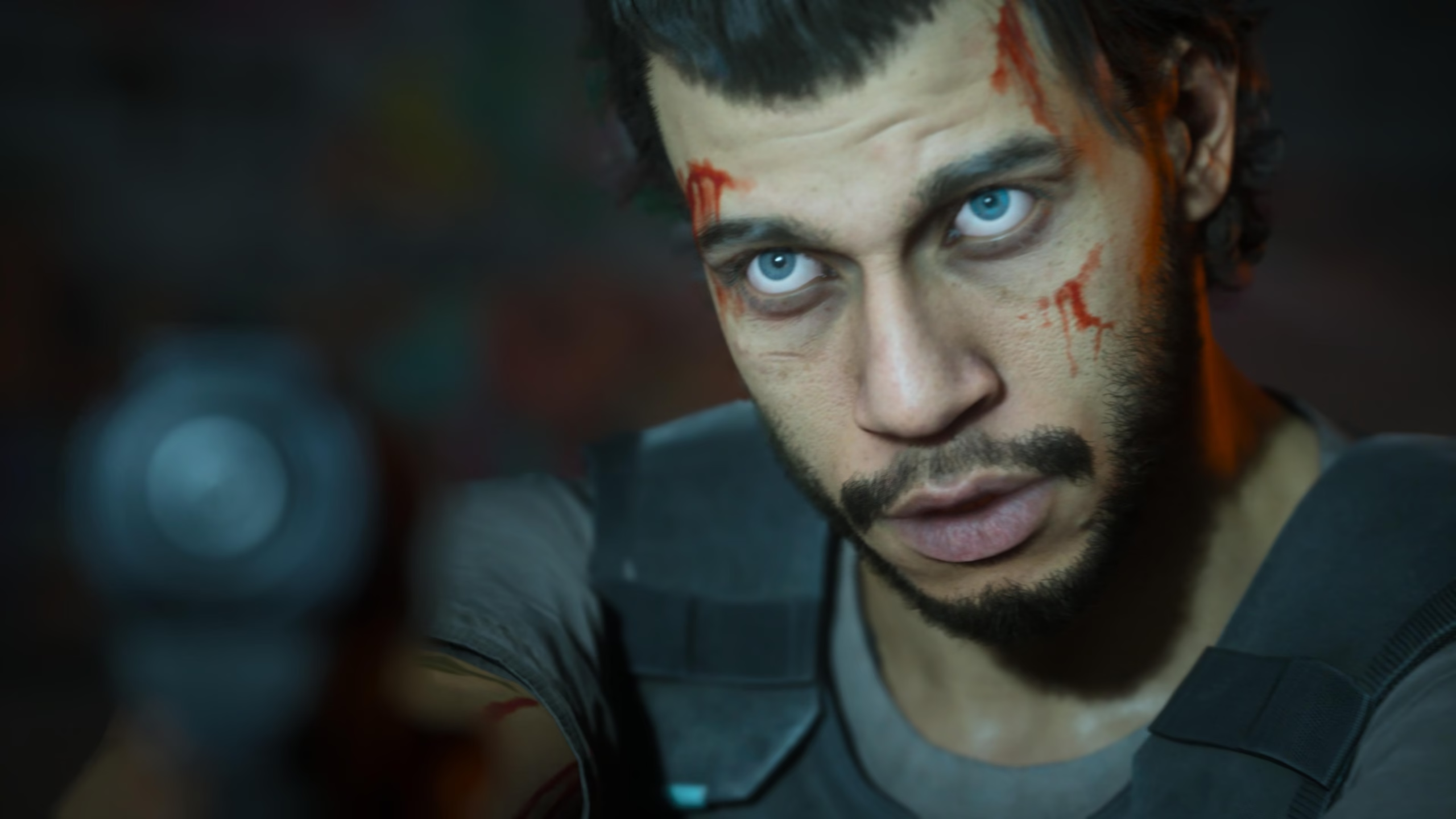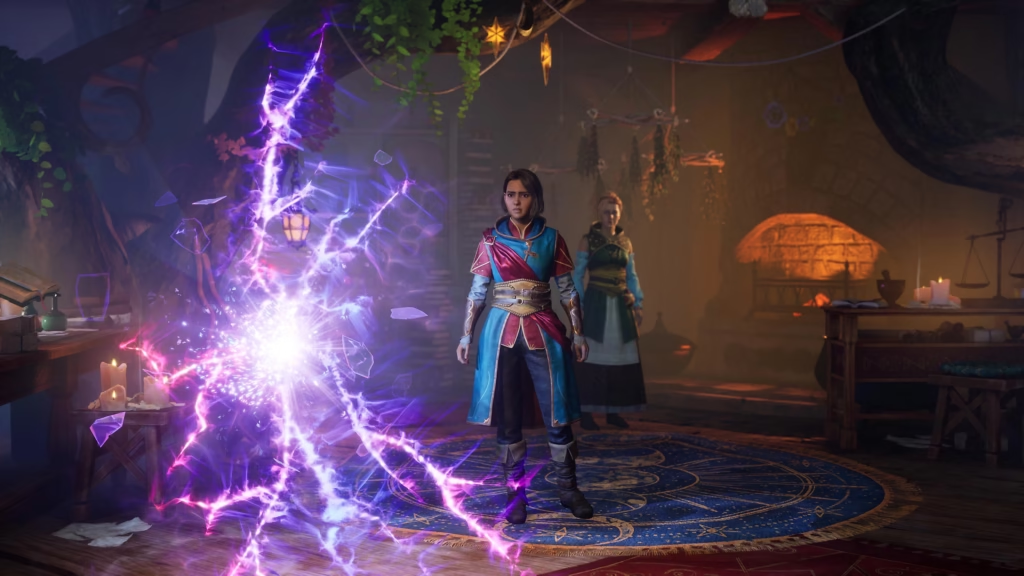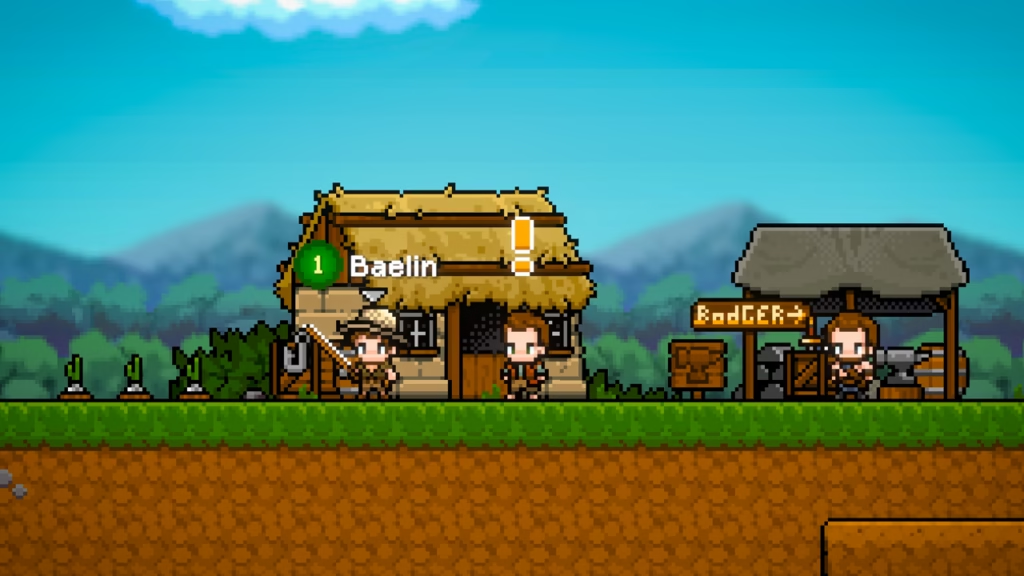First things first, and despite Build A Rocket Boy founder Leslie Benzies’ involvement in every Grand Theft Auto game — including expansion packs and mobile spinoffs — since GTA III, MindsEye was never intended to be a copy of (or killer of) those titles. It was, according to all reports, meant to be a very slick and linear experience that prioritised the narrative over sandbox elements. Which is perfectly fine, and something to be welcomed, I’d say. After all, in an increasingly dense fog of bloated open-world titles, a crisp and well-executed linear adventure might be just what the industry needs. Looking good so far.
Until you actually fire up the game, that is. As the opening credits rolled over MindsEye‘s first cutscene, a sense of unease crept over me as I saw the first sign of stutter. Then another. And then a third, before I realised that an extremely choppy video lay ahead. A quick restart later, there was less stutter, but stutter nonetheless. Was it the fact that I was playing on a base PlayStation 5, I wondered, but swiftly recalled that no matter how broken Cyberpunk 2077 was at launch, the cutscenes still played just fine and dandy on my ol’ PS4 Pro. Flash-forward a few minutes and with that cutscene establishing the background of the story, I was ready to dive into Redrock City as Jacob Diaz.
Eye of the beholder
Redrock City (an in-game reimagining of Las Vegas), and by extension MindsEye, weren’t bad-looking by any stretch of the imagination. As a matter of fact, there were certain parts of the city and its outskirts that looked downright fantastic. The lighting, particularly during dusk, for example, was quite magnificent. The vehicles looked very well-rendered and took damage realistically — which while par for the course even in 2015, was still nice to see. And finally, it was the various bits of technology, whether drones, robots, attack droids or computer systems, that looked quite era appropriate and well-modelled. In other words, my first impressions of the world were quite positive.
There was just something very stylish about the whole game, I thought. Whether that was the smartly designed and aesthetically pleasing menu, the soundtrack by Rival Consoles (an excellent mix of electronica themes), or the way Jacob leaned in and out of vehicles while riding shotgun for some target practice, everything pointed to what could potentially be a videogame version of a Michael Bay-Jerry Bruckheimer spectacle. And I mean that in the best way possible.

Beyond its look and sound, MindsEye actually possessed a handful of rather fun gameplay mechanics. Jacob’s collection of firearms grew as the game progressed, and he ended up with quite the arsenal of handguns, rifles, and a shotgun for good measure. Some of these felt better than others in combat, and it didn’t take long to identify which those were. Personally, I most enjoyed the effectiveness and handling of the sniper rifle a lot more than some of the automatic rifles that seemed about as effective as Nerf Guns.
To help out, Jacob also had a Drone Companion (DC), a beer can-sized gizmo that buzzed around him. Our protagonist could use it to infiltrate areas via small entry points, incapacitate enemies, hack electronics and so on. While initially, I found the switching back-and-forth from Jacob to DC a bit inefficient, I managed to do so a lot more seamlessly as the game progressed. The DC proved to be most useful in situations that required crowd control. And then there was the driving. I truly enjoyed the way vehicles (including cars, sky cars and drones) handled, and it felt like a lot of thought had gone into tuning them just right. A special word at this point for the cars, which I believe handled far better than anything I’d experienced in GTA V, Cyberpunk 2077 or even the most recent Saints Row title.
And finally, there were the narrative elements. For a game that, it may be recalled, was touted as a narrative-forward experience, this was certainly an area in which MindsEye did a good job. It wasn’t as though there was anything groundbreaking or revolutionary going on, however, in its 16 hours, I felt the game delivered a compelling story.

This, in turn, was aided by some high-quality voice acting. Sure, there were some hammy moments and enough hackneyed dialogue at which to shake a rolled-up copy of the Rambo: First Blood Part II script. But, it was an entertaining and action-packed romp.
Damn my eyes!
Now having laid on display every single thing I enjoyed about the game, it’s time to get into the truth of MindsEye. And that is that it simply wasn’t ready to be sent out into the world. Not by a long shot. Shortly after watching the February trailer, I recall being thoroughly impressed by the developer’s ambition and the game’s potential. Soon after came a slightly sub-par gameplay trailer and a shockingly early (considering it’d only been a few months that the launch trailer was out in the wild) release date of June 10. The virtually non-existent marketing was a red flag. That no one on the planet seemed to have received a review code was a veritable Communist rally. My own request was met with an “Unfortunately, we are unable to support at this time, but I appreciate you reaching out! We’ll be in touch if this changes“.
Undeterred, I procured the game post-launch and was promptly treated to the stuttering to which I’d alluded above. This was a symptom of a far bigger issue, and that was that MindsEye has either been very poorly optimised or not been optimised at all. In all, I experienced at least 10 cases of cutscene stutter, five or six prominent framerate drops (that actually affected my gameplay), near-constant ghosting (particularly on Jacob and a couple of vehicles) and two game-ending crashes. There are other technical areas in which the game felt very sloppy, but I’ll set those aside for now and get into the more critical issues.
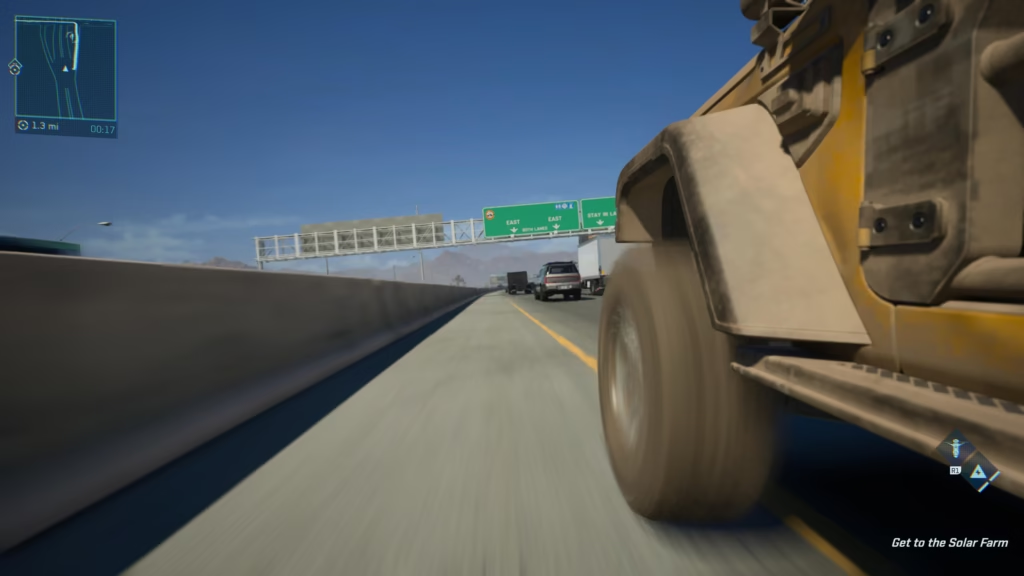
The aforementioned Cyberpunk 2077 dropped around four-and-a-half years ago in pretty pitiful condition. When it wasn’t NPCs exhibiting strange behaviour or missions getting locked because of some error or another, the game would frequently crash. I was able to drag my version of protagonist V and my PS4 Pro over the finish line not because these issues had somehow evaporated, but because the game was actually compelling. It encouraged me to try things, meet people, explore areas, find useful stuff and most importantly, stick around in Night City. MindsEye, in contrast, was in a tearing hurry to rush me through the game.
As I’d mentioned earlier, there were some fun gameplay mechanics I experienced over the course of the game, but they were almost always underutilised. An interesting minigame popped up once and never again. A couple of puzzles showed up to break up the flow, and were never seen again. A bit of stealth action. Yup, that wasn’t coming back either. Instead, most of my time in MindsEye was spent driving from A to B to C, and back to A. Now, the only thing keeping me from rage-quitting was that I enjoyed the whole driving thing, but there were a few close calls. A particular chase sequence with a punishingly steep difficulty spike comes to mind. It later became clear that these seemingly endless driving sequences were devised to dump information or exposition on me in the form of phone calls.
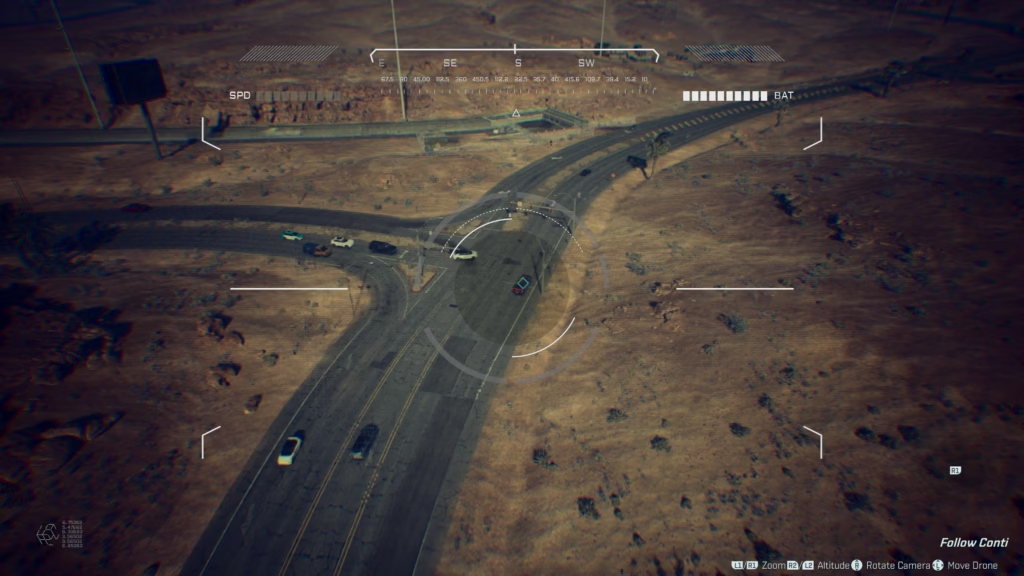
After the dump was complete, the game’s tendency to rush me along returned: This time, in the form of people calling me to say, “Hurry up!” or “Have you reached yet?” or “What’s taking so long?”. And this wasn’t restricted to driving segments. In fact, any part of the game that had me trying to figure out what to do next, saw these exhortations to get on with it pop up astonishingly quickly. A case in point was a mission that required me to snoop around in someone’s house for information. Barely had a minute of exploration passed before I had an NPC’s voice in my ear demanding that I step on it.
It’s clear that the game, and by extension the developers, want you to get on with things because, frankly, the other stuff isn’t even remotely ready for public consumption yet. And should you venture even slightly off the course during a mission, you are greeted with a fail state screen and sent right back to the start of the mission. I’ve never been to North Korea, but I got a good idea of how tourists in Pyongyang are reportedly treated — restricted to only the places the powers-that-be want them to see. During the course of one mission where I was allowed some amount of free-roaming, I saw solid reasons for why Build A Rocket Boy did not want me to move outside the stipulated pathways, and that’s because most of Redrock City was empty. Devoid of life. Dead.
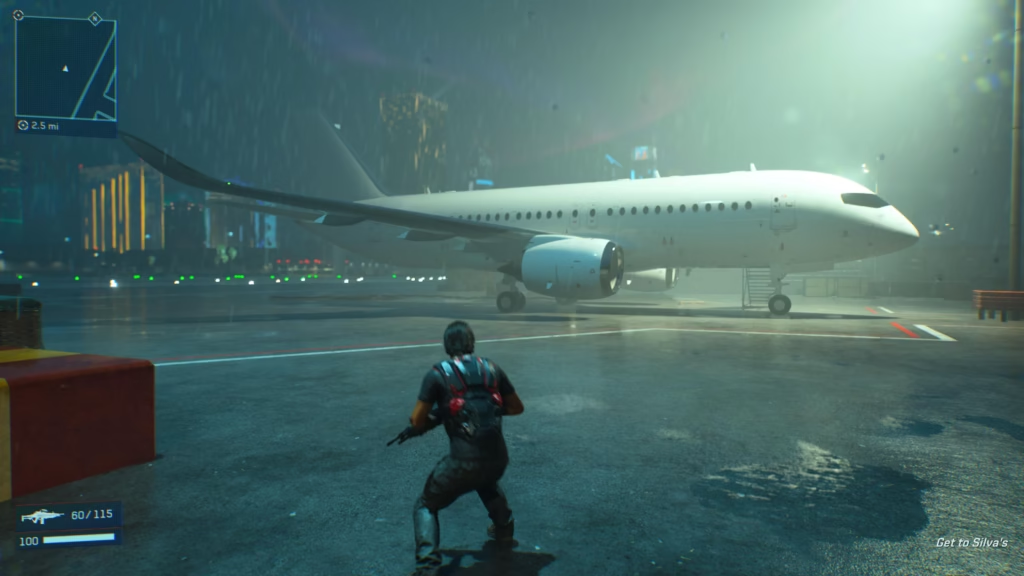
The fact that I couldn’t even find a single vehicle in which to make my way to the destination is testament to just how vacant the world of MindsEye truly was. The image above depicts a moment in my 25-minute trek (a journey that would’ve taken five or six minutes in a vehicle) that I began in a Jeep. What happened to the Jeep, you ask? Well, that brings us neatly to the next set of issues I have with this game: The incredibly strange AI.
Considering the sheer numbers of enemies you have to mow down in MindsEye, it’s probably the best place to start. The enemy AI was a mixed bag overall. On one hand, you had human and non-human enemies alike frequently taking up flanking positions and intelligently boxing me in. And they were quite adroit at picking me off from a distance. On the other hand, they were often running at walls or firing their weapons into space (perhaps asking their makers what they’d done to deserve the fate of being coded this way). Sometimes, they were even huddled in a corner with their backs to me, making them sitting ducks for some prime headshots.

But the vehicular AI made what I discussed above seem like the enemy AI from Alien: Isolation. I’ve played enough driving games to expect being rammed off the road by enemies. Hell, by this point, I’m used to bracing for impact or executing evasive manoeuvres to get out of trouble. What nothing prepared me for was being bumped, jackknifed or sideswiped by random civilian vehicles. This happened repeatedly and mostly in sections where time was of the essence, but one moment in particular took the cake: The Jeep incident. There I was, driving peacefully along a nice stretch of highway, admiring the texture of the road, the way the dust rose from the desert and the lovely moonlight. All of a sudden, a nondescript SUV driving in the opposite direction swerved right into me and devastated my car. So I picked myself up, dusted myself off and set off to commandeer me a new car.
And that’s when I realised another one of MindsEye‘s delightful quirks: You couldn’t get into most cars. You couldn’t even intimidate drivers by firing at their vehicle, forcing them to abandon it. And do you know what else the game wouldn’t let me do? Engage in melee combat. That’s right, there was no way apart from guns and your DC to attack enemies. Close-quarters combat? Forget about it! You need to quickly draw your shotgun or pistol and blow them away. I could go on and on with this section all day, but I think you get the general idea that this game was far from ready.
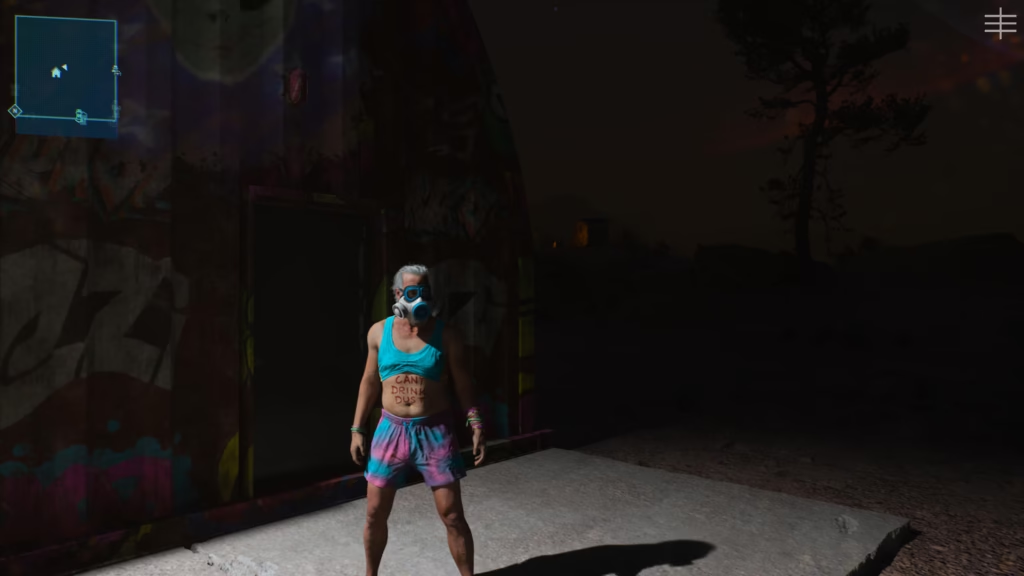
Eye haven’t a clue
Once the end credits had rolled and the post-credit sequence left me more aggravated than eagerly anticipating a sequel, came a message from the development team. It read, “You can now… free roam in Redrock City and explore at your leisure”. A couple of things to note here: The first is that ‘free roaming’ has you start off in the manner shown in that image above. And second, there’s absolutely nothing to do. That there were no police officers in the main game to catch me if I broke the law was weird. Weirder still was that the Free Roam mode had no cops either — meaning there was no consequence to anything I chose to do.
This sort of half-assedness symbolises the state in which MindsEye was released. On its part, Build A Rocket Boy provided assurances in that endgame message that “[new] content made by our dev team and selected builders will be regularly added to the ‘Play’ menu and in Free Roam” and that PC players could build their own content too. While on one hand, it’s mildly reassuring that maybe this isn’t it for the game and that there may be updates, patches and expansions incoming, it’s quite galling that the developer wants the paying public to basically build out the game.

I don’t believe that there are many studios around like Hello Games or CD Projekt Red that would continue working on broken games (No Man’s Sky and Cyberpunk 2077 respectively) until they were acceptable. I would like to believe that Build A Rocket Boy is among them, but on current evidence, I wouldn’t bet on it. And the reason I say that is that MindsEye isn’t broken. As a matter of fact, there’s evidence of polish in a handful of areas. MindsEye is undercooked, incomplete and a cynical exercise in shipping games. This sets an ugly precedent — one that is rather sickening to contemplate as the price of games gets steeper and steeper. In short, not only do you not get a full game for your money, but now you have to put in your own hard work to make it an actual game. Chew on that.
Retail copy of the game reviewed on PlayStation 5
